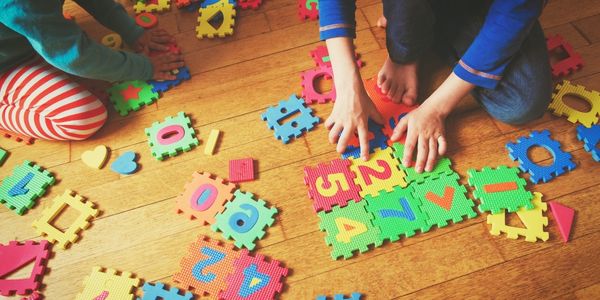
One of the top pediatric health concerns in the United States is the increase in childhood obesity. The percentage of obese children in the United States has more than tripled since the 1970s, and most obese kids go on to become obese adults. Today, about one in five school-aged children (ages 6–19) is obese, according to the Center for Disease Control and Prevention (CDC).
Not only can childhood obesity impact one’s physical health, but there are a variety of social and emotional issues that can result from it as well. Children with obesity are more likely to have chronic health conditions such as asthma, type 2 diabetes, sleep apnea, bone and joint problems and risk factors for heart disease, according to the CDC. Depression, low self-esteem, bullying and social isolation are other issues that can arise from childhood obesity, so it’s important to consider ways to prevent these rising statistics among kids.
Obesity in children is influenced by a variety of factors, including but not limited to one’s genetics, metabolism, upbringing and economic situation. While teachers can't control what happens outside of their classrooms, they can be positive role models and encourage healthy behaviors. We enlisted the help of some professionals for advice on what teachers can do to help turn the tide and set a good example for the students under your care.
A guide to childhood obesity prevention in the classroom
1. Promote and implement health education for your students
Many kids have no idea what is involved in a healthy diet or exercise regime, or what equates to a healthy lifestyle in general. Many adults have no idea either, for that matter, but when you’re young, it’s especially tough to even have an awareness of that kind of thing.
“Use your expertise as an educator to reinforce healthy habits in the curriculum regardless of subject matter,” says Dr. Jarrett Patton. “Teaching health and nutrition throughout the day can help lead children to live healthier lives at home."
Working healthy lifestyle lesson plans into your curriculum will not only give kids an awareness of their own health, but you’ll also be able to encourage and spark ideas about how to keep healthy on a regular basis and stay healthy in the future.
“Teach them about healthy eating, suggest new recipes or introduce students to gardening,” suggests Corina Bethencourt, a teacher at Miami-Dade County Public Schools. “A great resource for teachers is the Let's Move initiative.”
2. Get kids moving with physical fitness activities
According to the U.S. National Library of Medicine - National Institutes of Health, the guidelines for children state that 60 minutes of physical activity is recommended per day, as well as 30 minutes of vigorous activity three times per week. While it may be a standard requirement for the curriculum at your school, making sure your students have adequate time to get physical activity in outside or in the gymnasium is essential.
There are other ways you can work in physical fitness activities in the classroom as well. “Incorporate activity into lesson plans during the day,” says Patton. “This could be as simple as providing a stretch break for the kids or allowing for a few minutes of simple calisthenics like jumping jacks or push-ups.”
3. Encourage healthy snacks
Making sure the school you’re working at has healthy guidelines in place regarding school lunches and snacks is essential to promoting good health in the classroom. If you’re in charge of providing snacks for your students, make sure you’re choosing healthy options: fruits, vegetable, whole-grain options and foods high in protein.
If parents are in charge of providing their kids with snacks for the day, there’s no harm in sending home a letter detailing ideas for healthy snack options, but at the same time, it’s important to respect the decisions parents make for their children. You can educate, but it’s important not to pressure kids or their parents.
“Modeling from teachers should be in the form of respect for meals, snack times and eating with children,” says Adina Pearson, a family dietician. “Show them a calm and relaxed attitude about food and the importance of taking time to nourish oneself.”
4. Keep yourself healthy
Your role as a teacher gives you the opportunity to make a huge impact on your students. Not only do kids often look up to their teachers, but they will also certainly watch how you handle yourself and manage your own life.
When kids learn that one of your priorities is staying healthy, eating nutritious foods and pursuing physical fitness, they may be more likely to pursue those things as well. Don’t stop with yourself—get your whole staff on board. Promote health initiatives at your school, have competitions with prizes, and play games that will get everyone on board with keeping healthy.
5. Rally for positive health programs and policies at your school
Schools as a whole have made great strides toward pursuing healthier options and putting policies in place to promote the health of students, faculty and staff. Government programs have certainly helped move things along, as well. Not all schools are necessarily on board, however, and it’s up to you speak up and advocate on behalf of your students.
Many of the strides that have already been made are due to teachers like you who have rallied for change and pursued making a difference, so don’t be afraid to stand up and make your voice heard.
Nutrition and fitness can be fun!
Reducing the risk and cases of childhood obesity in the U.S. should certainly be a priority for all of us, and hopefully the ideas listed above will give you a good starting point for making a difference. If you’re looking for some fun fitness ideas to incorporate in your classroom, check out our article, “Get Movin’: 15 Fun Fitness Activities for Kids.”




